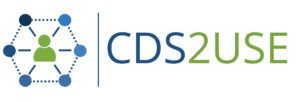Prospective User-Centered Design of Clinical Decision Support Systems in the Context of Personalized Medicine
About the project

Clinical decision support systems in the context of personalized medicine are seen as having great potential. There are numerous studies showing that such systems can increase diagnostic accuracy, improve clinical outcomes, avoid errors caused by information deficiencies and improve physicians’ decisions through faster and more comprehensive access to relevant data. However, despite all the recent technological advances, many challenges remain: Research shows that clinical decision support systems are insufficiently accepted and used, for example, because physicians fear a reduction of their professional autonomy, users do not trust the system or the systems are not seen as suitable for the respective workflows. Furthermore, such systems can also be associated with unintended negative consequences (provocation of errors, generation of irrelevant alarms). This is mainly due to the fact that no systematic, user-centred development process is followed, which places the users with their tasks and their specific working environment in the centre of the development activities from the very beginning. Thus, successful implementation – in addition to the completeness and accuracy of the evidence base – also depends significantly on the user- and context-adapted design and the integration of the systems into everyday clinical work. The results of the junior research group CDS2USE should help to ensure that the innovative, intelligent solutions developed within the framework of MIRACUM are designed in a user-centred way in order to ensure the broad and sustainable use of such intelligent IT systems in everyday practice.
Goals
The CDS2USE junior research group pursues three scientific goals:
Goal 1: Develop algorithms for context-sensitive decision support:
A major challenge in the development of decision support systems is the provision and use of context-sensitive data, as the identification and delineation of different contexts in the medical field is largely unexplored. Therefore, algorithms of the medical informatics initiative are to be adapted, combined and supplemented in such a way that the systems are enabled to present the right (relevant) information, to the right person, at the right time, in the right (relevant) context. In doing so, competing factors and values that influence clinical decision-making must also be adequately considered.
Goal 2: Develop “intelligent explanation tools”/a transparent and comprehensible decision support:
Currently, existing concepts and approaches of human-computer interaction are not sufficient for the user to understand clinical decision support systems. Therefore, concepts are to be developed that present the results to the users in an explainable, transparent and comprehensible way and enable them to gain individual control over the system on the basis of “intelligent explanation tools” and thus to deal with “their” data in a confident manner.
Goal 3: Further develop existing evaluation methods for a fit to clinical decision support systems:
Numerous recommendations exist for user-adapted design and evaluation of interactive systems, but these do not take into account the specific medical context. Existing evaluation methods are therefore to be further developed and adapted or expanded for clinical decision support systems in the context of personalised medicine. In particular, both new methods for evaluation with regard to the comprehensibility of system proposals/results and new methods for testing intelligent visualisations that prepare the information from the complex data sets in a user-friendly way are to be developed.
Project schedule
Three work phases – set-up, implementation and generalization – are planned to achieve the goals:
Set-up phase (year 1-1.5):
Based on the state of the art in science and technology, requirements for the development of algorithms for context-sensitive decision support systems are specified, existing concepts for a transparent presentation of results are identified and possible evaluation methods for a user-centred system design are compiled. The work is closely linked to the MIRACUM use cases.
Implementation phase (years 1.5-3):
The results for the MIRACUM use cases developed in the set-up phase are continued, validated and iteratively refined or adapted. In addition, the results (concepts, methods, tools) are tested for new use cases.
Generalization phase (year 4-5):
The developed methods and tools are transferred and adapted for as many types of decision support systems as possible in the context of personalized medicine.
To achieve its goals, the junior research group places a systems engineering approach at the centre of its research, which takes equal account of the end user (human), the technology used (engineering) and the work processes (organization). In addition, the group conducts “participatory research” involving medical staff, patients and decision-makers (depending on the work in question) to ensure that the results produced take into account the actual needs and specific situation of the people directly affected.
Lead of the Junior Research Group

Dr. Brita Sedlmayr
Lead of the Junior Research Group CDS2USE
Institute for Medical Informatics and Biometry | Technical University Dresden – Medical Faculty Carl Gustav Carus
Team
Publications
Journal publications
- Schütze D, Holtz S, Neff MC, Köhler SM, Schaaf J, Frischen LS, Sedlmayr B, Müller BS. Requirements analysis for an AI-based clinical decision support system for general practitioners: a user-centered design process. BMC Med Inform Decis Mak. 2023 Jul 31;23(1):144. doi: 10.1186/s12911-023-02245-w. PMID: 37525175.
- Schüttler C, Zerlik M, Gruendner J, Köhler T, Rosenau L, Prokosch HU, Sedlmayr B. Empowering Researchers to Query Medical Data and Biospecimens by Ensuring Appropriate Usability of a Feasibility Tool: Evaluation Study. JMIR Hum Factors. 2023 Apr 19;10:e43782. doi: 10.2196/43782. PMID: 37074765.
- Zerlik M, Jung I-C, Sehr T, Hennings F, Kamann C, Brandt MD, Sedlmayr M, Sedlmayr B. A pragmatic methodical framework for the user-centred development of an electronic process support for the sleep laboratory patients’ management. Digital Health. 2022;8. doi:10.1177/20552076221134437
- Schaaf J, Sedlmayr M, Sedlmayr B, Storf H. User-Centered Development of a Diagnosis Support System for Rare Diseases. Stud Health Technol Inform. 2022 May 16;293:11-18. doi: 10.3233/SHTI220341. PMID: 35592954.
- Gruendner J, Deppenwiese N, Folz M, Köhler T, Kroll B, Prokosch HU, Rosenau L, Rühle M, Scheidl MA, Schüttler C, Sedlmayr B, Twrdik A, Kiel A, Majeed RW. Architecture for a feasibility query portal for distributed COVID-19 Fast Healthcare Interoperability Resources (FHIR) patient data repositories: Design and Implementation Study. JMIR Med Inform. 2022 May 25;10(5):e36709. doi: 10.2196/36709. PMID: 35486893; PMCID: PMC9135115.
- Sedlmayr B, Sedlmayr M, Kroll B, Prokosch HU, Gruendner J, Schüttler C. Improving COVID-19 Research of University Hospitals in Germany: Formative Usability Evaluation of the CODEX Feasibility Portal. Appl Clin Inform 2022;13(2):400–409. Doi: 10.1055/s-0042-1744549
- Zoch M, Sedlmayr B, Knapp A, Bathelt F, Helfer S, Schmitt J, Sedlmayr M. Interdisziplinärer Versorgungspfad und mögliche IT-Unterstützung für Menschen mit Seltenen Erkrankungen in Deutschland [Interdisciplinary care path and potential IT support for people with rare diseases in Germany]. Z Evid Fortbild Qual Gesundhwes. 2021 Oct;165:68-76. German. doi: 10.1016/j.zefq.2021.06.004. Epub 2021 Sep 3. PMID: 34483074.
- Leutner LA, Bathelt F, Sedlmayr B, Sedlmayr M, Zoch M. Development of a Dashboard for Rare Diseases – A Technical Case Report. Stud Health Technol Inform. 2021 Sep 21;283:78-85. doi: 10.3233/SHTI210544. PMID: 34545822.
- Schüttler C, Prokosch HU, Sedlmayr M, Sedlmayr B. Evaluation of Three Feasibility Tools for Identifying Patient Data and Biospecimen Availability: Comparative Usability Study. JMIR Med Inform. 2021;9(7):e25531. Published 2021 Jul 21. doi:10.2196/25531
- Schaaf J, Sedlmayr M, Sedlmayr B, Prokosch HU, Storf H. Evaluation of a clinical decision support system for rare diseases: a qualitative study. BMC Med Inform Decis Mak. 2021;21(1):65. Published 2021 Feb 18. doi:10.1186/s12911-021-01435-8
Conference papers
- Ahmadi N, Zoch M, Sedlmayr B, Schuler K, Hahn W, Sedlmayr M, Wolfien M. Context-Sensitive Common Data Models for Genetic Rare Diseases – A Concept. Stud Health Technol Inform. 2023 Jun 29;305:139-140. doi: 10.3233/SHTI230443. PMID: 37386977.
- Bathelt F, Reinecke I, Sedlmayr B, Höhne S, Gierschner C, Sedlmayr M. Visualization of Medical Wearable-Data Using SMART-on-FHIR – A Concept for an Interdisciplinary Complex Practical Course. Stud Health Technol Inform. 2022 Aug 31;298:61-65. doi: 10.3233/SHTI220908. PMID: 36073457.
- Gruendner J, Deppenwiede N, Folz M, Hummel M, Kiel A, Kroll B, Köhler T, Lablans M, Majeed R, Rosenau L, Sedlmayr B, Szimtenings L, Twrdik A, Prokosch HU, Rühle M, Scheid MA, Schüttler C. Verteilte Machbarkeit – Eine Brücke zwischen Bioproben und Daten. Distributed Feasibility – A Bridge Between Biospecimens and Data. In: Hummel M, Jahns R, Kientopf M et al (Hrsg.). Nachhaltige Verankerung von Biobanken als Forschungsinfrastruktur: Tagungsband des 10. Nationalen Biobanken-Symposiums vom 1. – 2. Juni 2022 in Berlin (Nationales Biobanken Symposium – Jahresbericht), Hannover: ibidem; 2022, S.23-27.
- Sedlmayr B, Ahmadi N, Jung IC, Zerlik M, Sedlmayr M Prospective user-friendly design of clinical decision support systems – first results of the Junior Research Group CDS2USE. Deutsche Gesellschaft für Medizinische Informatik, Biometrie und Epidemiologie. 66. Jahrestagung der Deutschen Gesellschaft für Medizinische Informatik, Biometrie und Epidemiologie e. V. (GMDS), 12. Jahreskongress der Technologie- und Methodenplattform für die vernetzte medizinische Forschung e.V. (TMF). sine loco [digital], 26.-30.09.2021. Düsseldorf: German Medical Science GMS Publishing House; 2021.
Further Readings
- Sedlmayr M & Sedlmayr B. 2023. Digitalisierung der Leitlinienarbeit und Entscheidungsunterstützungssysteme. In: Günster, C et al (eds.), Versorgungs-Report Leitlinien. Berlin: Medizinisch Wissenschaftliche Verlagsgesellschaft. DOI: https://doi.org/10.32745/9783954668007-20
- Sedlmayr B, Jung IC, Schuler K, Zerlik M. CDS2USE: nutzerzenrierte gestaltung im fokus – Forschung für eine breite und nachhaltige Nutzung klinischer Entscheidungsunterstützungssysteme. gesundhyte.de – Das Magazin für Digitale Gesundheit in Deutschland. Ausgabe 15 Juni 2023, S.24 f..
- Engelmann K, Valtink M, Lohse A, Sedlmayr M, Bathelt F, Reinecke I, Sedlmayr B, Röhle A, Eva Bibrack E. Der Mensch im Mittelpunkt einer sich wandelnden Arbeitskultur in der Medizin – Wir gemeinsam mit diversen Blickwinkeln. In: Ärzteblatt Sachsen (Hrsg.): Teamwork- wie Alt und Jung sich ergänzen. Themenheft Generationen. 33. Jahrgang, November 2022, Quintessenz Verlags-GmbH, Seite 20-23; ISSN 0938-8478.
Further Information
Presentations
- Presentation MIRACUM Kolloquium (16.02.2021)
- Presentation MIRACUM Symposium (16.07.2021)
- Lecturer MIRACUM Summer School (13.10.2021)
News / Articles
- MIRACUM Journal #4 (July 2021)
- MIRACUM on Twitter (10.07.21)
- MIRACUM on Twitter (16.07.21)




